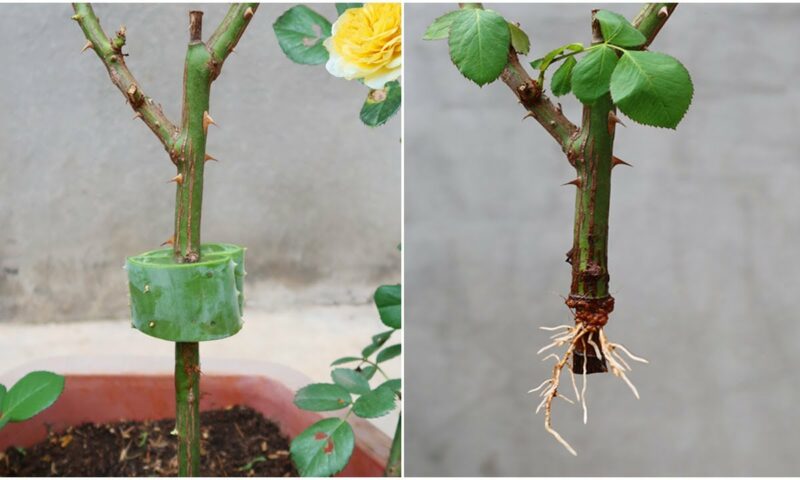If you’re a gardening enthusiast and love roses, propagating roses from stem cuttings can be an exciting and cost-effective way to multiply your rose garden. With a little patience and care, you can potentially propagate hundreds of new rose plants from a single parent plant.
Here’s a step-by-step guide on how to propagate roses from stem cuttings and enjoy an abundance of beautiful roses in your garden.

Materials Needed:
Healthy rose plant: Choose a healthy and disease-free rose plant as your parent plant for taking stem cuttings. Look for a plant with vigorous growth and abundant blooms for the best results.

Sharp pruning shears: Use sharp and clean pruning shears to take stem cuttings from the parent plant. Clean tools help prevent the spread of diseases.

Rooting hormone: Rooting hormone is a powdered or liquid substance that helps stimulate root growth in cuttings. It can be purchased at a garden center or online.

Potting mix: Choose a well-draining potting mix that is suitable for roses. Avoid heavy soils or garden soil, as they can retain too much moisture and lead to rot.
Pots or containers: You’ll need pots or containers to plant the rose cuttings in. Choose small pots or containers with drainage holes to allow excess water to drain out.

Plastic bags or cloches: Plastic bags or cloches can be used to create a greenhouse-like environment for the rose cuttings, which helps retain moisture and promote rooting.
Watering can or spray bottle: You’ll need a watering can or a spray bottle to water the cuttings and keep the potting mix evenly moist.

Step 1: Select and Prepare the Stem Cuttings
Choose healthy stem cuttings: Look for healthy and mature stems on the parent plant that are about pencil-thick and have a minimum of two to three leaf nodes. Leaf nodes are the points where the leaves attach to the stem.
Take the cuttings: Using sharp pruning shears, make a clean cut just below a leaf node to create a stem cutting that is about 6-8 inches long. Remove any flowers or buds from the stem, as they can divert energy from root development.
Remove lower leaves: Strip off the leaves from the bottom two-thirds of the stem, leaving only a few leaves at the top to help with photosynthesis.
Optional: Dip in rooting hormone: If desired, you can dip the bottom end of the stem cutting in rooting hormone to promote root growth. Follow the instructions on the rooting hormone package for best results.
Step 2: Plant the Stem Cuttings
Fill pots with potting mix: Fill small pots or containers with well-draining potting mix, leaving about an inch of space from the top.
Plant the stem cuttings: Insert the bottom end of the stem cutting into the potting mix, burying at least two leaf nodes below the soil surface. Press the soil gently around the cutting to secure it in place.
Water thoroughly: Water the potting mix thoroughly until water drains out from the bottom of the pots. Allow the pots to drain for a few minutes before placing them in plastic bags or covering them with cloches.

Step 3: Create a Greenhouse-like Environment
Cover with plastic bags or cloches: Place a clear plastic bag or a cloche over each pot to create a greenhouse-like environment that retains moisture and promotes rooting. If using a plastic bag, loosely seal the bag to allow for airflow.
Place in a bright, indirect light: Place the pots in a location with bright, indirect light, such as a windowsill or a greenhouse. Avoid direct sunlight, as it can cause overheating and drying out of the cuttings.
Maintain humidity: Check the moisture level of the potting mix regularly and water as needed to keep it evenly moist, but not waterlogged. Avoid letting the potting mix dry out completely, as it can hinder root development.
Step 4: Wait for Rooting
Be patient: It can take several weeks to a few months for the rose cuttings to root and develop into new plants. Be patient and resist the temptation to disturb or check on the cuttings too often, as it can disrupt the rooting process.
Monitor for growth: After a few weeks, you may start to see new growth, such as leaves or stems, emerging from the cuttings. This is a sign that rooting has occurred.
Step 5: Transplanting and Care of New Plants
Transplant the rooted cuttings: Once the cuttings have developed a good root system, carefully remove them from the pots and transplant them into individual pots or directly into the ground in your garden. Use well-draining potting mix or garden soil mixed with compost.
Provide care for new plants: Water the newly transplanted rose plants regularly and provide them with appropriate sunlight and temperature conditions for optimal growth. Protect them from extreme weather conditions, pests, and diseases. As the new plants grow and mature, you can gradually acclimate them to the outdoor environment.








